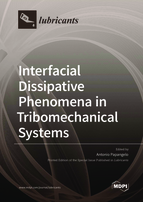Interfacial Dissipative Phenomena in Tribomechanical Systems
A special issue of Lubricants (ISSN 2075-4442).
Deadline for manuscript submissions: closed (31 October 2020) | Viewed by 27105
Special Issue Editor
2. Department of Mechanical Engineering, Hamburg University of Technology, Am Schwarzenberg-Campus 1, 21073 Hamburg, Germany
Interests: friction; adhesion; dissipation; nonlinear dynamics; contact nonlinearities
Special Issue Information
Dear Colleagues,
In the last twenty years, tribology and nonlinear dynamics have included several major contributions related to key topics such as rough contact, friction, damping mechanisms, and dynamical behaviour of nonlinear systems, which are paving the way for future engineering challenges. The two fields are largely intertwined as, among the others, contact nonlinearities are almost omnipresent in any technical application ranging from the development of NEMS/MEMS to bioengineering, automotive, civil/mechanical industry, and aerospace.
The common thread in both fields is the study of interfaces, particularly of the dissipative phenomena that take place at the interface, providing the source of damping that is exploited to reduce the vibration amplitude of mechanical systems, improving their service life. Despite the great achievements obtained, we are still far from being able to predict the dynamical behaviour of mechanical systems involving contact interfaces. Contamination of knowledge between tribology and nonlinear dynamics is of outmost importance today to develop strategies to respond promptly to future challenges.
The current Special Issue aims at bringing together, in the same Issue, contributions from world-leading scientists working in the fields of tribology and nonlinear dynamics, with the goal being to favour “contamination” of knowledge from the two fields to deepen our understanding of engineering regarding interfacial dissipation and dynamical system responses. Contributions are welcome from all scientists working in tribology, dynamics, and related areas.
Dr. Antonio Papangelo
Guest Editor
Manuscript Submission Information
Manuscripts should be submitted online at www.mdpi.com by registering and logging in to this website. Once you are registered, click here to go to the submission form. Manuscripts can be submitted until the deadline. All submissions that pass pre-check are peer-reviewed. Accepted papers will be published continuously in the journal (as soon as accepted) and will be listed together on the special issue website. Research articles, review articles as well as short communications are invited. For planned papers, a title and short abstract (about 100 words) can be sent to the Editorial Office for announcement on this website.
Submitted manuscripts should not have been published previously, nor be under consideration for publication elsewhere (except conference proceedings papers). All manuscripts are thoroughly refereed through a single-blind peer-review process. A guide for authors and other relevant information for submission of manuscripts is available on the Instructions for Authors page. Lubricants is an international peer-reviewed open access monthly journal published by MDPI.
Please visit the Instructions for Authors page before submitting a manuscript. The Article Processing Charge (APC) for publication in this open access journal is 2600 CHF (Swiss Francs). Submitted papers should be well formatted and use good English. Authors may use MDPI's English editing service prior to publication or during author revisions.
Keywords
- Friction
- Viscoelasticity
- Hysteresis
- Adhesion
- Soft materials
- Damping mechanisms
- Contact mechanics
- Structural dynamics
- Nonlinear dynamics
- Friction damped systems
- Friction-excited systems
- Dampers and joints






